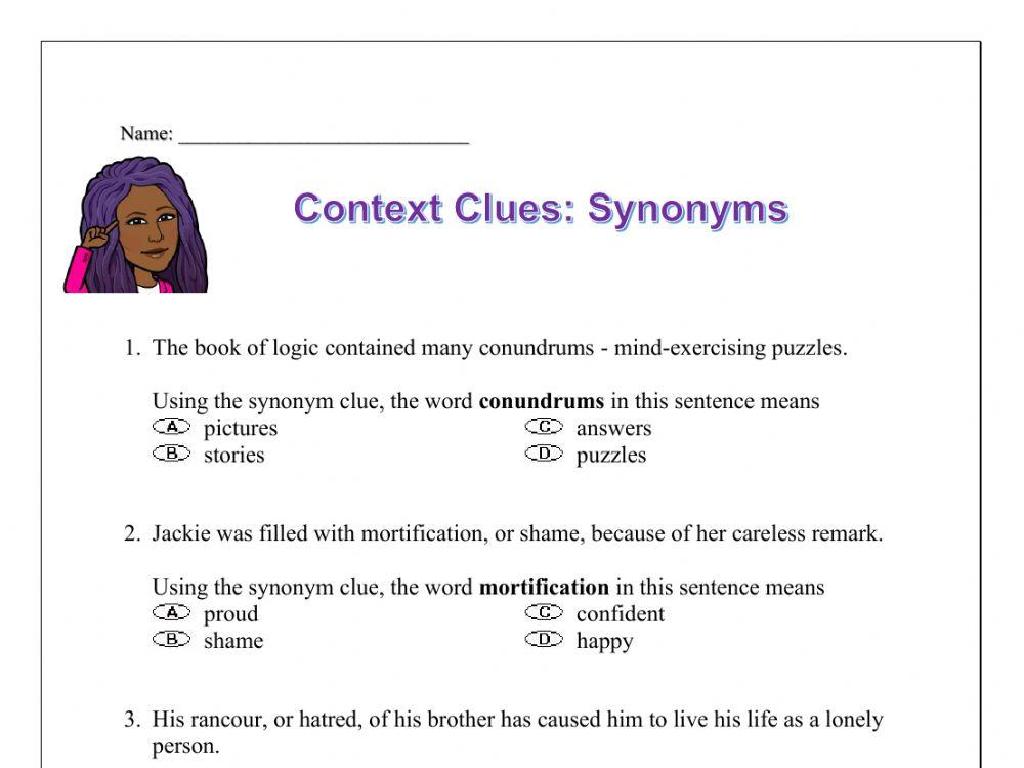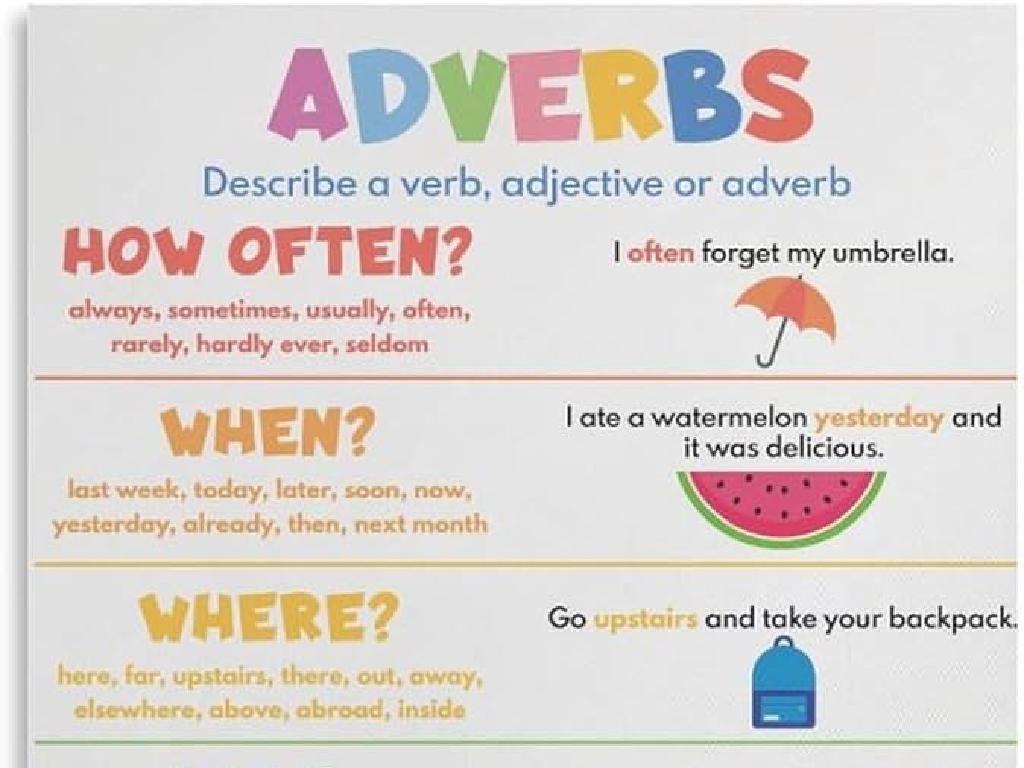Identify The Meaning Of Idioms And Adages: Set 2
Subject: Language arts
Grade: Fifth grade
Topic: Idioms And Adages
Please LOG IN to download the presentation. Access is available to registered users only.
View More Content
Exploring Idioms and Adages
– Define idioms and adages
– Idioms are expressions with a figurative meaning different from the literal words; adages are old, short sayings that express a general truth.
– Phrases with non-literal meanings
– ‘Break a leg’ doesn’t mean to literally break a leg, it means ‘good luck’.
– Common idioms and adages examples
– ‘Spill the beans’ means to reveal a secret, and ‘The early bird catches the worm’ means that success comes to those who prepare well and put in effort.
– Significance in language
– Understanding these helps us communicate more effectively and creatively.
|
This slide introduces students to idioms and adages, which are phrases that convey meanings different from their literal interpretation. Idioms are a key part of everyday language and often reflect cultural idiosyncrasies, while adages are traditional sayings that offer advice or wisdom. Provide examples that are commonly used in daily conversation to help students relate to the material. Encourage them to think of idioms or adages they have heard at home or in media. Discuss how these phrases make language more colorful and expressive. The goal is for students to recognize and understand these phrases when they encounter them in reading or conversation.
Exploring Idioms: Colorful Language
– What are idioms?
– Idioms are phrases with a meaning different from the words’ literal meaning.
– Idioms make language vibrant
– They add fun and emotion to our conversations, making them more expressive.
– ‘Piece of cake’ means very easy
– Used when something is so simple, you can do it with no trouble at all.
– ‘Break a leg’ means good luck
– Said to wish someone success, especially before a performance.
|
This slide introduces students to idioms, which are phrases that cannot be understood from the meanings of their individual words but have a separate meaning of their own. Explain that idioms are used to add an element of fun and color to our language, making conversations more engaging and expressive. Provide examples like ‘Piece of cake’ to illustrate an easy task, and ‘Break a leg’ as a way to wish someone good luck, especially in the performing arts. Encourage students to think of idioms they have heard and discuss the figurative meaning behind them. This will help them understand how idioms function in everyday language.
The World of Adages
– What are adages?
– Adages are short, memorable sayings with a valuable lesson.
– Timeless wisdom of adages
– They offer advice that has been true for many years.
– ‘Early bird catches the worm’
– This means that someone who is proactive will be successful.
– ‘Actions speak louder than words’
– It’s better to actually do something than just talk about it.
|
This slide introduces students to adages, which are short but wise sayings that express a general truth or piece of advice. Explain that adages have been passed down through generations because their messages remain relevant and useful. Use the examples provided to illustrate how adages work. ‘The early bird catches the worm’ can be discussed in the context of taking initiative or being proactive. ‘Actions speak louder than words’ emphasizes the importance of doing rather than just saying. Encourage students to think of situations in their own lives where these adages might apply. Ask them to bring in adages they have heard at home or in their community for further discussion.
Idioms and Adages in Context
– Grasping idioms and adages via context
– Idioms and adages often can’t be understood word-for-word, but context can reveal their meaning.
– Read passages to spot special phrases
– Find idioms and adages in the story and underline them.
– Discuss meanings of each phrase
– What do you think ‘hit the hay’ or ‘spill the beans’ means in our story?
– Contextual understanding is key
– Understanding the story helps us get the phrases.
|
This slide aims to teach students how to derive the meaning of idioms and adages from the context in which they are used. Begin by explaining that idioms and adages are phrases that express a thought or wisdom that can’t be understood literally. Provide students with reading passages containing idioms and adages, and instruct them to identify these phrases. Once identified, open a class discussion to explore the meanings of each phrase, encouraging students to explain how they used context clues to understand them. Emphasize that the surrounding words and the overall situation in the story provide hints about what these phrases mean. This exercise will enhance their comprehension skills and appreciation for figurative language.
Crafting Our Idioms and Adages
– Create your own idioms and adages
– Share with classmates and explain
– Explain the meaning behind your phrases
– Discuss how to use them in talks
– Practice using them in sentences
– Understand idioms and adages better
|
This activity is designed to engage students in the creative process of developing their own idioms and adages, fostering a deeper understanding of figurative language. Encourage students to think about common experiences or observations that could translate into a witty or insightful phrase. After creation, students will share their idioms and adages with the class, explaining the intended meaning and possible context. This will help them grasp how these phrases enrich language and make communication more colorful. Provide guidance on how idioms and adages reflect cultural wisdom and are often used to succinctly express complex ideas. For the activity, consider breaking the class into small groups to allow for more intimate sharing and discussion. Offer examples like ‘spill the beans’ or ‘when pigs fly’ to get their creativity flowing.
Class Activity: Idiom and Adage Charades
– Divide class into small groups
– Act out idioms or adages silently
– Use body language and gestures to convey the idiom or adage
– Guess the phrase
– Think about what the acted phrases could mean
– Explain the meaning
– Discuss as a class what each phrase means in context
|
This activity is designed to make learning idioms and adages interactive and fun. By dividing the class into small groups, students can collaborate and engage in the learning process. Each group will choose an idiom or adage to act out silently, using only body language and gestures. The rest of the class will guess the phrase being acted out and then explain its meaning, promoting critical thinking and comprehension. For the teacher: Prepare a list of idioms and adages for the groups to choose from. Ensure that each group has a turn to perform and guess. Encourage students to be creative in their expressions and to use context clues from the actions to infer meaning. After each performance, facilitate a brief discussion to ensure the correct interpretation of the idiom or adage is reached. This activity will help students remember these phrases and their meanings more effectively.
Review and Reflection: Idioms and Adages
– Recap today’s idioms and adages
– Go over the phrases we learned today
– Discuss language enrichment
– How idioms and adages add flavor to language
– Share idioms from home/media
– Bring any phrases you’ve heard outside of class
– Reflect on the usage of phrases
– Think about how these phrases are used in conversations
|
This slide aims to consolidate the students’ understanding of idioms and adages learned in today’s lesson. Start by recapping the phrases discussed and their meanings. Engage the class in a discussion about how these expressions make language more colorful and expressive. Encourage students to share idioms or adages they have encountered in their daily lives, whether at home or through various media, to understand the prevalence and relevance of these phrases. Conclude with a reflection on how these phrases enhance communication and encourage students to start using them in their writing and speech to enrich their language skills.






